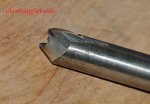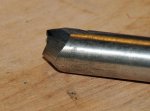Ned Bulken
Member
- Messages
- 5,529
- Location
- Lakeport NY and/or the nearest hotel
Awhile back I received a very generous gift from Vaughn, a pair of Benjamin's Best HSS bowl gouges. Over the years I've barely used them and up until very recently I've not had the proper set up to put the fingernail grind on them. Well I finally have most of the ducks in a row, my grinder, shop built wolverine clone (works for the most part... for now...) and a vari-grind tool holder from Oneway.
I've managed to royally mess up one of the gouges, to the point where I'm resigned to losing a fair amount of steel in order to fix things:

for now, ignore the Notch which is about 3/8" back from the bevel. I'm treating my error as a lesson in how not to do things. And hopefully I'll be able to fix that notch when I"m a bit more advanced.
I'm treating my error as a lesson in how not to do things. And hopefully I'll be able to fix that notch when I"m a bit more advanced.
OK
here are more pics of the current issue: I've managed to create a snaggletooth by focusing on the point of the gouge instead of doing a nice even sweep.






I attempted tonight to put something resembling the fingernail sweep back on, laying it way over on both sides, and then working it back and forth, spending less time in the middle.
I've got a white wheel and one of the original courser grit wheels on the grinder. The opposite side from this is beginning to look more like a typical elsworth or fingernail grind, my question is, should I simply keep on working on the finer grit wheel until I have both sides looking alike?
OR should I move over to the courser grit wheel to take more material off and get past the ugly point, and get the fingernail pattern established, Then switch over to the finer wheel for 'finishing'?
I realize I'm going to 'lose' a fair amount of steel in fixing this, so be it. I'd rather learn on this gouge than whichever one I buy to upgrade from it. (can you say Thompson? I thought you could...)
I've managed to royally mess up one of the gouges, to the point where I'm resigned to losing a fair amount of steel in order to fix things:

for now, ignore the Notch which is about 3/8" back from the bevel.
OK
here are more pics of the current issue: I've managed to create a snaggletooth by focusing on the point of the gouge instead of doing a nice even sweep.






I attempted tonight to put something resembling the fingernail sweep back on, laying it way over on both sides, and then working it back and forth, spending less time in the middle.
I've got a white wheel and one of the original courser grit wheels on the grinder. The opposite side from this is beginning to look more like a typical elsworth or fingernail grind, my question is, should I simply keep on working on the finer grit wheel until I have both sides looking alike?
OR should I move over to the courser grit wheel to take more material off and get past the ugly point, and get the fingernail pattern established, Then switch over to the finer wheel for 'finishing'?
I realize I'm going to 'lose' a fair amount of steel in fixing this, so be it. I'd rather learn on this gouge than whichever one I buy to upgrade from it. (can you say Thompson? I thought you could...)

